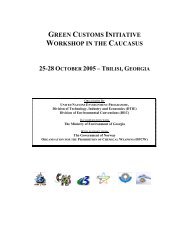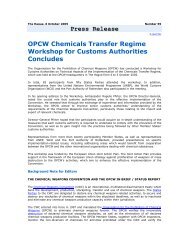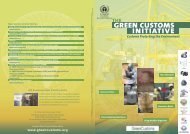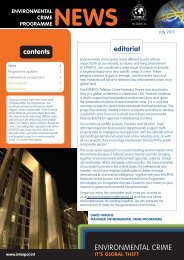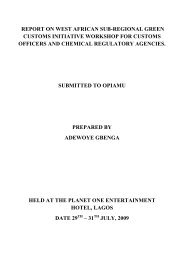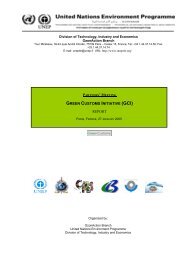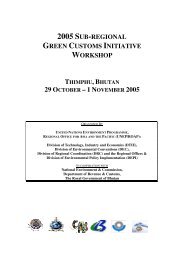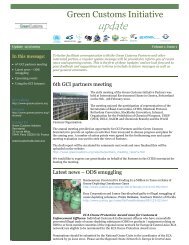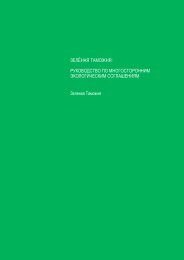Arusha - Green Customs Initiative
Arusha - Green Customs Initiative
Arusha - Green Customs Initiative
You also want an ePaper? Increase the reach of your titles
YUMPU automatically turns print PDFs into web optimized ePapers that Google loves.
Introduction to Convention on International Trade in Endangered Species of Wild<br />
Fauna and Flora (CITES)<br />
Ms Elisabeth Mrema representing UNEP-DEC gave an overview on CITES. She informed<br />
that the overall objective of CITES is to ensure that wild fauna and flora in international trade<br />
are not exploited unsustainably to cause their extinction. She said that CITES has been in<br />
operation for 30 years now. She further pointed out that the Convention establishes an<br />
international legal framework together with common procedural mechanisms for the<br />
prevention of international commercial trade in endangered species applicable in 169 country<br />
Parties to CITES to regulate and monitor international trade in wild resources.<br />
Ms Mrema described that species subject to CITES regulations are provided under three<br />
Appendices. Appendix I deals with species threatened with extinction and therefore<br />
international (commercial) trade is generally prohibited and includes almost 530 animal<br />
species and some 300 plant species. Appendix II covers species not necessarily threatened<br />
with extinction, but for which international trade is permitted but regulated and contains more<br />
than 4,400 animal species and more than 28,000 plant species. Appendix III deals with species<br />
for which a country is asking Parties to help with its protection whereby international trade is<br />
permitted but regulated (less restrictive than Appendix II) and includes some 255 animal<br />
species and 7 plant species. She mentioned that CITES regulates the export, re-export and<br />
import of live and dead animals and plants and their parts and derivatives (for listed species<br />
only) through a system of permits and certificates. All countries that join the Convention must<br />
adopt legislation for its implementation and designate Management Authority and Scientific<br />
Authority. On one hand, the Management Authority has two basic roles: communicating with<br />
the CITES Secretariat and other Parties and granting permits and certificates under the terms<br />
of the Convention. On the other hand, the Scientific Authority provides advice to the<br />
Management Authority does scientific identification of specimens and determines the national<br />
status of CITES species.<br />
Ms Mrema noted that although no role is specified for <strong>Customs</strong> in the Text of the Convention,<br />
the Convention specifies that trade requires the presentation of valid permits or certificates,<br />
which usually involves <strong>Customs</strong>, especially at points of entry. She pointed out that <strong>Customs</strong><br />
Officers, and other responsible agencies involved in border inspection, are usually the first<br />
(and sometimes the only) level of inspection of shipments of CITES specimens. She was<br />
therefore of the view that this places a great burden on <strong>Customs</strong> to verify that trade is in<br />
accordance with CITES, detect fraud and illegal trade where it occurs, and inform the<br />
Management Authority. <strong>Customs</strong> Officers face challenges such as specimens are not always<br />
easy to identify, identifying invalid documents and forgeries, seizures can pose challenges,<br />
and handling of specimens can be dangerous to safety. In this regard, she emphasized that<br />
inter-agency cooperation and partnerships at the national level are essential among CITES<br />
National Authorities, <strong>Customs</strong>, Police, Judiciary, Media and relevant Sector Ministries.<br />
Lusaka Agreement on Cooperative Enforcement Operations Directed at Illegal Trade in<br />
Wild Fauna and Flora<br />
Mr. Stephen Kisamo, Director of the Lusaka Agreement Task Force based in Nairobi, Kenya,<br />
gave an overview of the Lusaka Agreement. He informed that illegal trade in wildlife is on the<br />
increase and more sophisticated, ranking as the third largest business after drugs and weapon<br />
in international trafficking with estimated earnings at US$ 5-10 billion per annum. He further<br />
19



